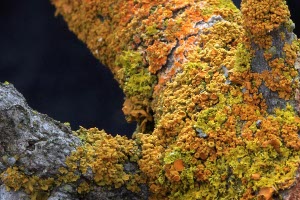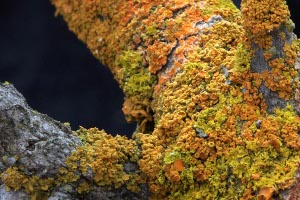Listen to the QUEST radio story Lichen Point to Pollution.
The southern walls of Yosemite Valley are covered in black crust. Last year, Hutton repelled hundreds of feet down the cliffs to survey the species living here. “All sorts of different colors. All sorts of different shapes. They’re really special. There are no trees up there. There’s no shade.” Hutton says there are more than 500 species of lichen in Yosemite and many grow where few other plants can.
Lichens Connected to the Air
Despite looking tough, lichens are some of the most sensitive organisms in the ecosystem. Hutton uses a fallen tree branch to point out the species living there. “I see really deep saturated orange and that is Caloplaca. And there’s just this beautiful just deep saturated yellow and that is the yellow of the Candelaira.”
The yellow lichen, Candelaira, is warning sign for Hutton. “If you were to go to place with very little air pollution, then you would not be seeing this many of these Candelaria species,” said Hutton.
While most plants get nutrients from the ground, lichens get much of what they need from the air. “They are basically directly connected to the atmosphere. They’re connected to all of it. They see all of it. It’s one of the reasons they’re so sensitive,” said Hutton.
Lichen are sensitive to changes in the air, especially from air pollution. That makes them an indicator of bigger ecosystem changes. Hutton and his team are taking lichen samples at 300 sites around the park and analyzing them to see what story they tell.
Measuring Pollution in the Ecosystem
Further into a nearby pine forest, Hutton and his team have set up funnels that collect air pollution samples. But it’s clear something else has gotten there first. Hutton’s equipment is strewn across the ground, the victim of a curious black bear.
“Yeah, basically a bear grabbed this funnel and plucked it off the stake. They just want to make sure that there’s no food associated with this plastic funnel,” said Hutton.
This is one of 12 sites where researchers are measuring a key ingredient of air pollution: nitrogen. Nitrogen oxides are produced by car and truck exhaust. In Yosemite, nitrogen pollution isn’t only from nearby cars. It also arrives from elsewhere in the state.
“We all have experienced the westerly winds that happen that blow stuff essentially from over the ocean, across the Central Valley and up into the mountains,” said Lee Tarnay, Air Resource Specialist at Yosemite National Park.
Air pollution from urban areas is blown into the Sierra Nevada mountains by those westerly winds. And the problem is: nitrogen pollution is sticky. “That gas likes to stick to pine needles and just about anything else. And these trees act as a giant collector for the gases that stream through the air,” said Tarnay.
When it rains, the nitrogen pollution is washed off the pine needles and deposited on the ground. As any backyard gardener knows: nitrogen is a fertilizer.
“All plants need nitrogen to grow. And some plants need a lot of nitrogen and some need only very little. And so in Yosemite, we already had enough nitrogen to begin with,” said Hutton. Sierra Nevada forests are adapted to low levels of nitrogen.
Impact of Nitrogen Pollution in the Ecosystem
“We’re worried that additional fertilizer in Yosemite could have effects that we might not anticipate. We think that the Yosemite is system as is it should be now. So we want to make sure that if there’s something harming or changing that balance, then we want to know that,” said Hutton.
Hutton says that balance is already under threat by invasive plants and many respond to higher nitrogen levels. Nitrogen can also encourage more ground plants to grow, a major concern in fire country. “If you increase the amount of nitrogen, you have plants that basically fill up the space in between these natural patches. And so that means that fires can spread a lot better.”
Reducing car traffic in Yosemite could help cut air pollution. It will also depend on regional air districts across California, several of which, like the San Joaquin Valley, exceed federal air pollution limits. Hutton says he’s hopeful that research in Yosemite will help them identify pollution hotspots and manage the changes in the field.
37.756313 -119.59716
 A tree branch covered in nitrogen-loving lichen. (Credit: Martin Hutton)Air pollution may seem like an urban problem, but it’s becoming an increasing concern in California’s national parks.
A tree branch covered in nitrogen-loving lichen. (Credit: Martin Hutton)Air pollution may seem like an urban problem, but it’s becoming an increasing concern in California’s national parks. 